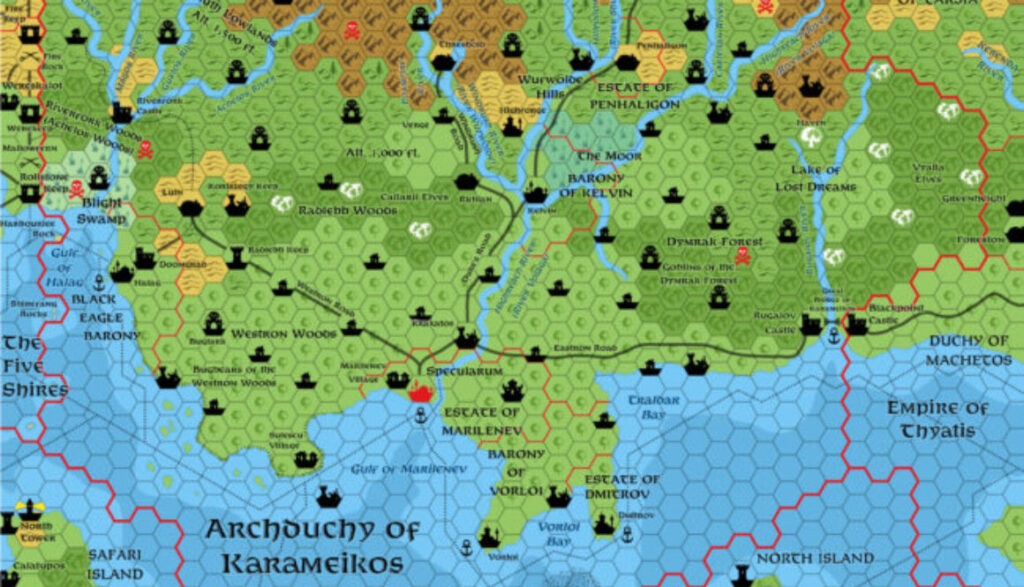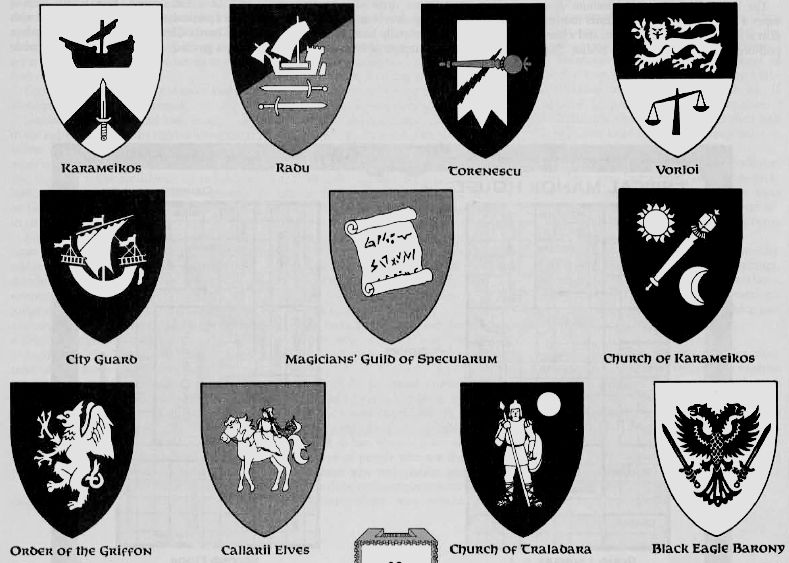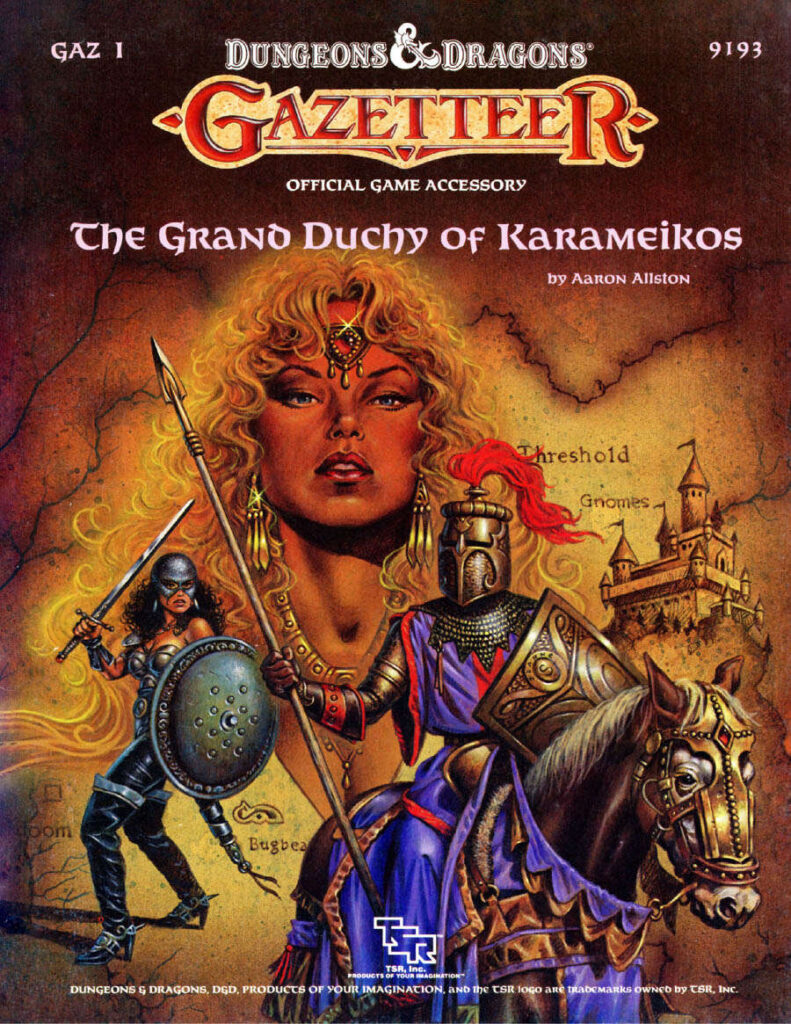Publisher: Wizards of the Coast (previously TSR)
Introduction
The Grand Duchy of Karameikos is a classic accessory for the Dungeons & Dragons fantasy role-playing game, published by TSR in 1987. It is the first in a series of Gazetteers that explore the world of Mystara, a setting that combines medieval and pre-industrial elements with magic and exotic cultures. The Grand Duchy of Karameikos introduces the nation of Karameikos, a former Thyatian province that gained its independence after a bloody civil war. Karameikos is a land of contrasts, where the native Traladaran people struggle to preserve their traditions and identity under the rule of the Thyatian-descended Duke Stefan Karameikos and his nobles. Karameikos is also a land of adventure, where ancient ruins, dark forests, and mysterious cults hide secrets and dangers for the brave and curious.

Content
The Grand Duchy of Karameikos is divided into two sections: the Gazetteer and the Adventure.
Gazetteer
The Gazetteer provides a wealth of information for players and Dungeon Masters, covering the history, geography, politics, society, economy, and culture of Karameikos, as well as its notable characters, monsters, and magic items. The Gazetteer also includes a large color map of the nation, showing its major cities, towns, villages, roads, rivers, and landmarks.
Some of the highlights of the Gazetteer are:
- The history of Karameikos, from its ancient origins as a land of nomadic tribes, to its colonization by the Thyatian Empire, to its recent independence and struggles. The history also covers some of the major events that shaped the world of Mystara, such as the Great Rain of Fire, the rise and fall of the Nithian Empire, the plague of lycanthropy that swept the islands of Minrothad, and the War of the Immortals.
- The geography of Karameikos, which is divided into three regions: the coastal lowlands, the central highlands, and the northern wilderness. Each region has its own features, climates, flora, and fauna, as well as its own challenges and opportunities for adventurers. The geography also describes some of the natural wonders and hazards of Karameikos, such as the Black Peak Mountains, the Lake of Lost Dreams, the Radlebb Woods, and the Caves of Chaos.
- The politics of Karameikos, which is a feudal monarchy ruled by Duke Stefan Karameikos, who is advised by a council of nobles and a parliament of representatives. The politics also covers the relations between the two main ethnic groups of Karameikos: the Thyatians, who are the descendants of the colonists and the ruling class, and the Traladarans, who are the natives and the majority of the population. The politics also reveals some of the internal and external threats and conflicts that Karameikos faces, such as the Iron Ring, a slaver organization, the Black Eagle Barony, a rogue state ruled by the evil Baron Ludwig von Hendriks, and the Five Shires, a neighboring nation of halflings that claims part of Karameikos as its own.
- The society of Karameikos, which is a blend of Thyatian and Traladaran cultures, as well as influences from other nations and races. The society also covers the aspects of daily life, such as the customs, laws, education, entertainment, fashion, food, and religion of Karameikos. The society also introduces some of the unique and colorful festivals and traditions of Karameikos, such as the Night of the Walking Dead, the Festival of Lucor, the Day of Dread, and the Callarii Dance of Life.
- The economy of Karameikos, which is based on agriculture, logging, mining, and trade. The economy also covers the types of coins, goods, services, and taxes that are used in Karameikos, as well as the main sources of income and expenditure for the nation. The economy also explains some of the economic opportunities and challenges that Karameikos faces, such as the competition from the Minrothad Guilds, the smuggling activities of the Veiled Society, the piracy of the Sea Wolves, and the exploration of the Lost Valley of Hutaaka.
- The culture of Karameikos, which is a rich and diverse mix of art, literature, music, and folklore. The culture also covers the languages, alphabets, names, and symbols that are used in Karameikos, as well as the legends, myths, and stories that are told and retold by the people. The culture also showcases some of the famous and influential figures and works of Karameikos, such as the poet Petrarch, the bard Teldon, the painter Elissa, and the book The Song of King Halav.
- The notable characters of Karameikos, who are the movers and shakers of the nation, as well as the allies and enemies of the adventurers. The notable characters include the Duke and his family, the nobles and their vassals, the clergy and their followers, the merchants and their associates, the wizards and their apprentices, the warriors and their companions, and the rogues and their contacts. The notable characters also feature some of the recurring villains and rivals of the Mystara setting, such as the evil wizard Bargle the Infamous, who appears in the D&D red box set as a introductory adventure, the Iron Ring leader Tharion, who is behind the kidnapping of the Duke’s niece, and the Black Eagle Baron Ludwig von Hendriks, who is plotting to overthrow the Duke and take over Karameikos.
- The monsters of Karameikos, who are the creatures and beings that inhabit the land, as well as the foes and challenges of the adventurers. The monsters include the common and uncommon animals, plants, and vermin, the classic and new fantasy races and creatures, the undead and the lycanthropes, and the immortals and their servants. The monsters also provide some of the statistics, abilities, and behaviors of the creatures, as well as some of the tips and tactics for encountering and defeating them.
- The magic items of Karameikos, who are the items and artifacts that have magical properties and powers, as well as the rewards and temptations of the adventurers. The magic items include the weapons and armor, the potions and scrolls, the rings and wands, and the miscellaneous and unique items. The magic items also give some of the descriptions, histories, and effects of the items, as well as some of the clues and hints for finding and using them.

The Iron Ring
One of the most notorious and dangerous organizations in Karameikos is the Iron Ring, a slaving ring that operates from the Black Eagle Barony, a rogue state ruled by the evil Baron Ludwig von Hendriks, who is a rival and enemy of Duke Stefan Karameikos. The Iron Ring is not a family affair like the Veiled Society, but a collective of independent criminals working together for mutual profit. The main business of the Iron Ring is slavery, kidnapping people from various lands and selling them to the highest bidder. The Iron Ring also engages in other illegal activities, such as smuggling, extortion, assassination, and sabotage. The Iron Ring is one of the major threats and conflicts that Karameikos faces, as it undermines the stability and security of the nation.
The Iron Ring has cells in all the major cities and towns of Karameikos, as well as in other neighboring nations, such as the Five Shires, Darokin, and Minrothad. The Iron Ring is composed of various types of criminals, such as bandits, cut-throats, lycanthropes, and even some corrupt nobles and officials. The Iron Ring is also allied with some of the enemies of Karameikos, such as the vampire Koriszegy, who hires them to carry out many of his evil schemes, including assassinations and kidnappings of important political leaders.
The Iron Ring is a recurring villain and rival of the Mystara setting, and it appears in several D&D products and adventures, such as the Order of the Griffon video game, the Gazetteer 1: The Grand Duchy of Karameikos, and the Karameikos: Kingdom of Adventure boxed set. The Iron Ring is a challenging and dangerous foe for the adventurers, as it has many resources, contacts, and secrets, as well as a ruthless and cunning leadership. The Iron Ring is also a source of moral and ethical dilemmas for the adventurers, as they have to decide how to deal with the victims and perpetrators of slavery, and whether to use violence or diplomacy to stop the Iron Ring’s operations.

The Monsters and Creatures of Karameikos
Karameikos is a land of diverse and rich ecology, where many types of monsters and creatures can be found. Some of the most common and notable ones are:
- Animals: Karameikos is home to a variety of wild animals, such as bears, wolves, boars, deer, hawks, owls, and snakes. Some of these animals are domesticated by the people, such as horses, dogs, cats, and sheep. Some of these animals are also preyed upon by other creatures, such as lycanthropes, vampires, and dragons.
- Plants: Karameikos is covered with thick forests, where many kinds of plants grow. Some of these plants are useful for food, medicine, or crafts, such as berries, herbs, flowers, and wood. Some of these plants are also dangerous or magical, such as poison ivy, wolfsbane, mandrake, and treants.
- Lycanthropes: Karameikos is plagued by a curse of lycanthropy, which afflicts many of its inhabitants. Lycanthropes are people who can transform into animal-like forms, such as werewolves, werebears, wereboars, and wererats. Lycanthropes are usually hostile and violent, especially during the full moon, when they lose control of their transformations. Lycanthropes can also spread their curse to others by biting or scratching them.
- Vampires: Karameikos is also haunted by a legacy of vampirism, which stems from an ancient evil that lurks in the land. Vampires are undead creatures that feed on the blood of the living, and can also turn their victims into vampires by draining them of their life force. Vampires are usually powerful and cunning, and have many abilities, such as shape-shifting, mind control, and flight. Vampires can also create spawn, which are weaker and subservient to their masters.
- Dragons: Karameikos is also a domain of dragons, which are the most majestic and fearsome creatures in the world. Dragons are reptilian beings that can fly, breathe fire, and cast spells. Dragons are also very intelligent and greedy, and often hoard treasure and knowledge. Dragons come in many colors and sizes, each with their own personality and alignment. Some of the dragons that dwell in Karameikos are green, red, black, and gold.
- Humanoids: Karameikos is also a territory of humanoids, which are races of human-like creatures that are usually hostile and savage. Humanoids include orcs, goblins, hobgoblins, bugbears, kobolds, and gnolls. Humanoids often live in tribes or clans, and raid the human settlements for food, loot, and slaves. Humanoids also worship dark gods and immortals, and sometimes ally with other evil forces, such as the Iron Ring or the Black Eagle Baron.
- Centaurs: Karameikos is also a refuge of centaurs, which are creatures that have the upper body of a human and the lower body of a horse. Centaurs are proud and noble, and live in harmony with nature. Centaurs often roam the forests and plains of Karameikos, and sometimes interact with the human and elven inhabitants. Centaurs are also skilled warriors and hunters, and use bows, spears, and swords as their weapons.
- Elves: Karameikos is also a home of elves, which are a race of long-lived and graceful humanoids that have a strong affinity with magic and nature. Elves are divided into two clans in Karameikos: the Callarii and the Vyalia. The Callarii occupy the forests of central Karameikos, in particular the Radlebb woods as well as Achelos and the westernmost part of Dymrak. The Vyalia live in the eastern forests, near the border with Thyatis. Elves are usually friendly and helpful to the human and demi-human inhabitants of Karameikos, and often aid them against the common enemies, such as humanoids, vampires, and the Black Eagle Baron.
These are some of the most prominent monsters and creatures of Karameikos, but there are many more that can be encountered in this land of adventure and mystery.
Adventure
The Adventure section offers four scenarios for different levels of play, ranging from a simple investigation of a haunted house to a complex intrigue involving a plot to overthrow the Duke. The Adventure section also includes suggestions for further adventures and campaigns in Karameikos, as well as tips for creating and running a Karameikan character.
Some of the highlights of the Adventure are:
- The Veiled Society, a scenario for 3rd-level characters, where the adventurers are caught in the middle of a feud between two rival families that are secretly controlled by a sinister organization. The scenario is a complex urban adventure, with investigation, infiltration, combat, and diplomacy, as well as a climax that involves a riot, a fire, and a showdown with the leader of the Veiled Society.
Conclusion
The Grand Duchy of Karameikos is a well-written and well-illustrated product that captures the essence and flavor of Karameikos and Mystara. It is a great source of inspiration and material for both players and Dungeon Masters who want to explore a rich and diverse fantasy world. The Grand Duchy of Karameikos is more than just a supplement, it is a gateway to a whole new realm of adventure.
The Grand Duchy of Karameikos on DrivethruRpg
